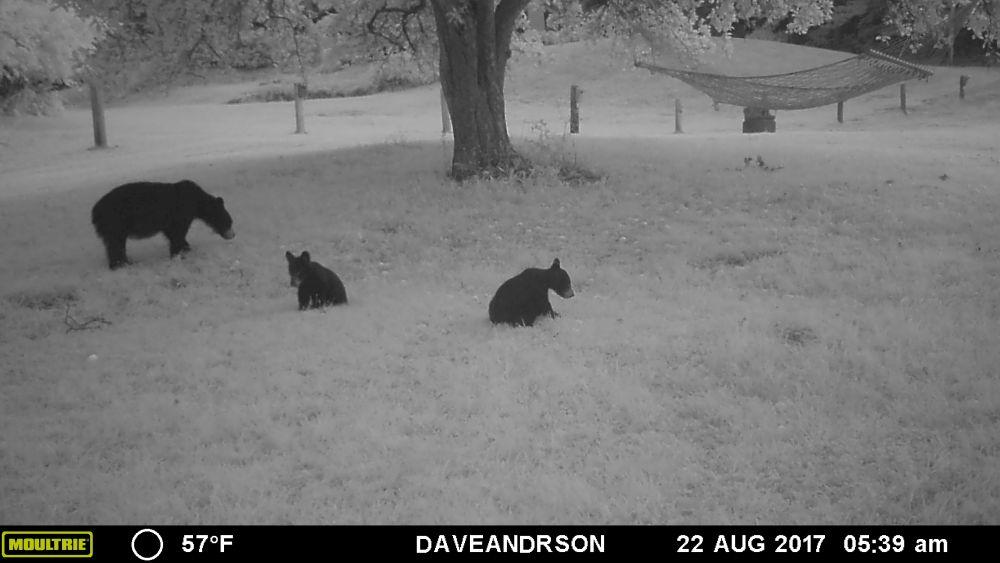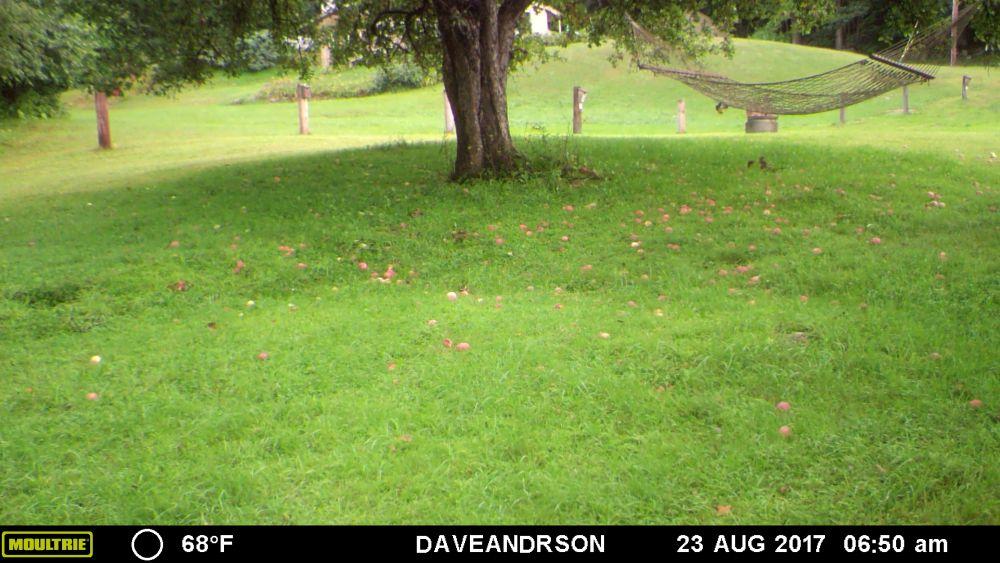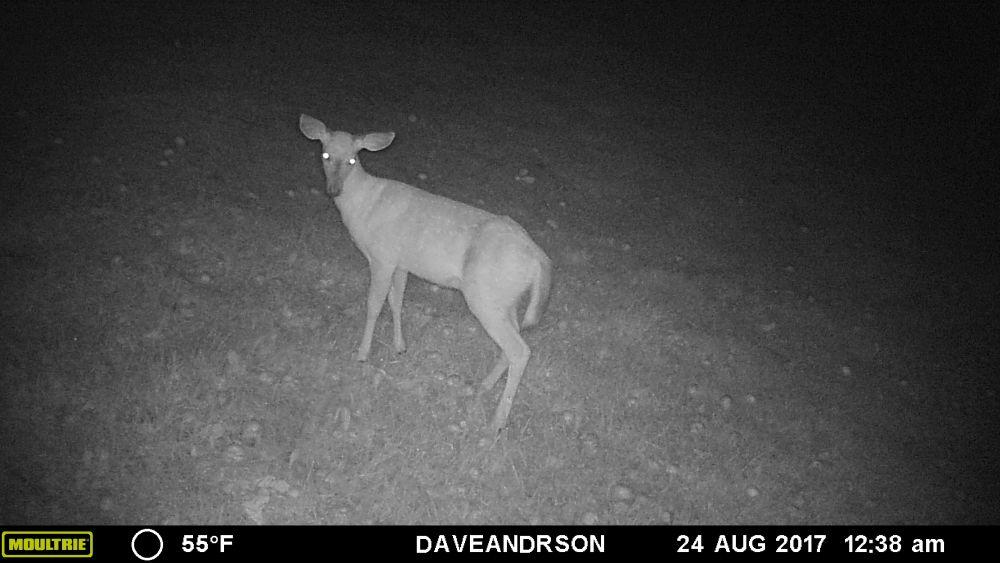Irresistible lure of fallen fruits draw nocturnal wildlife
- Tags:
- Wildlife

Bear cubs arrive to eat fallen apples in late August.
Backyard wildlife visit orchard by night
Fallen apples are like a restaurant dessert buffet at the edge of the woods. The sweet scent lures nocturnal wildlife to our backyard orchard by late summer as nights lengthen and the fallen apple accumulate, it happens every other year.
Two years ago, a bumper apple crop. Last year, a bust: zero apples. This year is another windfall – literally. The grass is littered with fallen fruit beneath two, ancient, early-bearing McIntosh trees. I intentionally leave grass unmown to avoid mincing the fruit.

I set-up a remote “apple cam” just outside the adjacent fenced chicken yard to see and learn more about our local critter neighbors. Usual nocturnal suspects include deer, porcupines, skunks, coyotes and bears. By day, gray squirrels, turkeys, crows and many songbirds feed on the apple pile.
We’ve not seen the local foxes or raccoons but we know they’re lurking. They’d prefer fresh chicken to apples. Our chickens and eggs are off the menu. We strive to provide vegetarian fare only to the extent that is possible.
Interesting interpretations come not just from which species are present, but how many and which individuals. Are there bears or coyotes we recognize from two years ago? How do they interact? Do they share the feast of fallen fruit? Year-to-year comparisons are difficult because local wildlife populations are fluid, ever-changing and the forest is vast.
The most numerous and frequent night visitors are deer, specifically female does with fawns. Regulars include a large doe with a single fawn and also smaller does, yearlings or siblings. Other cameras in remote locations of the woodlot are placed to catch portraits of local bucks, particularly one elusive patriarch. Thus far, we’ve seen no males on camera in the orchard or elsewhere. Bucks are elusive, wary and solitary. Does travel in mixed groups with fawns and yearlings born last year.

Other frequent visitors are porcupines which arrive in early evening and return several times per night. Porcupines enjoy diplomatic immunity. Nothing messes with them – would you? They’re relaxed, confident and cute as they deftly roll apples in their forepaws like little monkeys. Old timers called them “quill pigs” or “hedgehogs” which are a different, Old World European species not native to the US. The local porcupine population has been booming. Their only natural predators, fishers, have become rare judging by the absence of fisher tracks in snow for the past three winters.
Skunks are occasional visitors. This summer’s solitary skunk is nearly entirely black. Last autumn, a larger almost entirely white skunk and her offspring attempted to tunnel under fences to establish a winter residence beneath the fortified chicken coop. The camera revealed the skunk family digging by night. We sunk chicken wire a foot deeper and rolled larger stones onto the granite sills supporting the hen house. It’s like a Colonial Sanders Fort Knox.

Bears leave forest for apples
Bears returned for the first time this week, arriving just after dark and again before sunrise. We’ve been expecting them.
Black bear expert, Ben Kilham explains how forests supply black bears with the natural foods they require and decrease risks associated with people. Kilham is author of Among The Bears: Raising Orphaned Cubs in the Wild. Kilham operates NH’s only licensed orphan bear cub rehabilitation center. Kilham has cared for and released more than 130 bear cubs in the past 30 years.
Kilham explains “bears are fundamentally forest animals” Forests provide bears with food, concealment and travel corridors which connect suburbs to rural areas. Even narrow strips of woods provide safe travel lanes for bears. Forested edges of suburban housing and commercial businesses allow bears to connect larger blocks of adjacent forestland where food is plentiful and risks minimal. Kilham explains female black bears occupy a core home range averaging three to eight square miles. Males inhabit expanded ranges up to 200 square miles. Males are wide-ranging, traversing matriarchal territories of several different familial clans of females with cubs and mature offspring with their own cubs.
Kilham emphasizes bears prioritize natural food resources by quality, quantity and the inherent risks associated with obtaining calories. Bears essentially calculate profit and risk. Kilham explains how black oil sunflower seeds in backyard birdfeeders are of such high calorie content compared to natural foods, the “profit” of raiding backyard birdfeeders becomes worth the risk of crossing busy roads and encountering people or domestic dogs in suburban settings.
Kilham states “85% of bears’ natural diet comprises vegetation. The other 15% is animal protein; with 90 to 95% of that consisting of insects.” Ants, termites, wasps and their larvae are an underappreciated component of bear diets. Kilham fitted an orphan female bear he named “Yoda” with a radio-telemetry collar for long term study before she was released. In early autumn, Kilham observed Yoda sniffing out and digging-up ground hornet nests. Kilham recorded Yoda feeding at the rate of 12 to 16 hornet nests per hour. Kilham followed another study bear named “Squirtie” for a decade. Kilham says it was not uncommon for Squirtie to excavate 40 to 60 hornet nests per day while foraging. In autumn, ground hornet nests are packed with nutritious larvae, the fat-laden and protein-packed grubs destined to be adult hornets. Hornet stings do not deter bears from digging up nests. In a similar profit-to-risk calculation, hornet grub calories are worth enduring adult hornet stings.

Forests = Food
In summer, fruits and berries provide carbohydrates while insects – particularly ants and termites in rotting stumps and fallen rotting logs- provide protein and fat. Summer fruits include raspberries, blueberries, choke cherries and pin cherries. By August, forests supply fat-rich ripe beechnuts and beaked hazelnuts. When nut crops are sparse, nearby farmlands lure bears to sweet corn, fallen apples and pasture grasses along with inherent risks when leaving the shelter of the woods.
Forests provide a cornucopia of bear foods. Analysis of bear scats reveals wide-ranging travel. Kilham finds oak acorn scats deposited in forested swamps. Conversely, he finds wetland sedges including “nodding sedge” in bear scats deposited in oak forested ridge locations. Suburbs are riskier places for bears. Forests provide plentiful natural foods. For many years following recent logging, sunny patches regenerate fruiting berries and brushy thickets for concealment cover.
You remember the old cliché - “Does a bear… in the woods?” In fact, bears do everything in the woods.
Bear Hunting Begins September 1
New Hampshire’s bear population has increased and remains stable at approximately 6,100 bears statewide. The 2017 bear hunting season managed by the NH Fish & Game Department begins Friday September 1 statewide. Bear management objectives vary by region. This year, hunting opportunities have been expanded in some regions to stabilize population growth. Last year during the 2016 bear season, hunters took 898 bears representing nearly 15% of the estimated statewide bear population.
